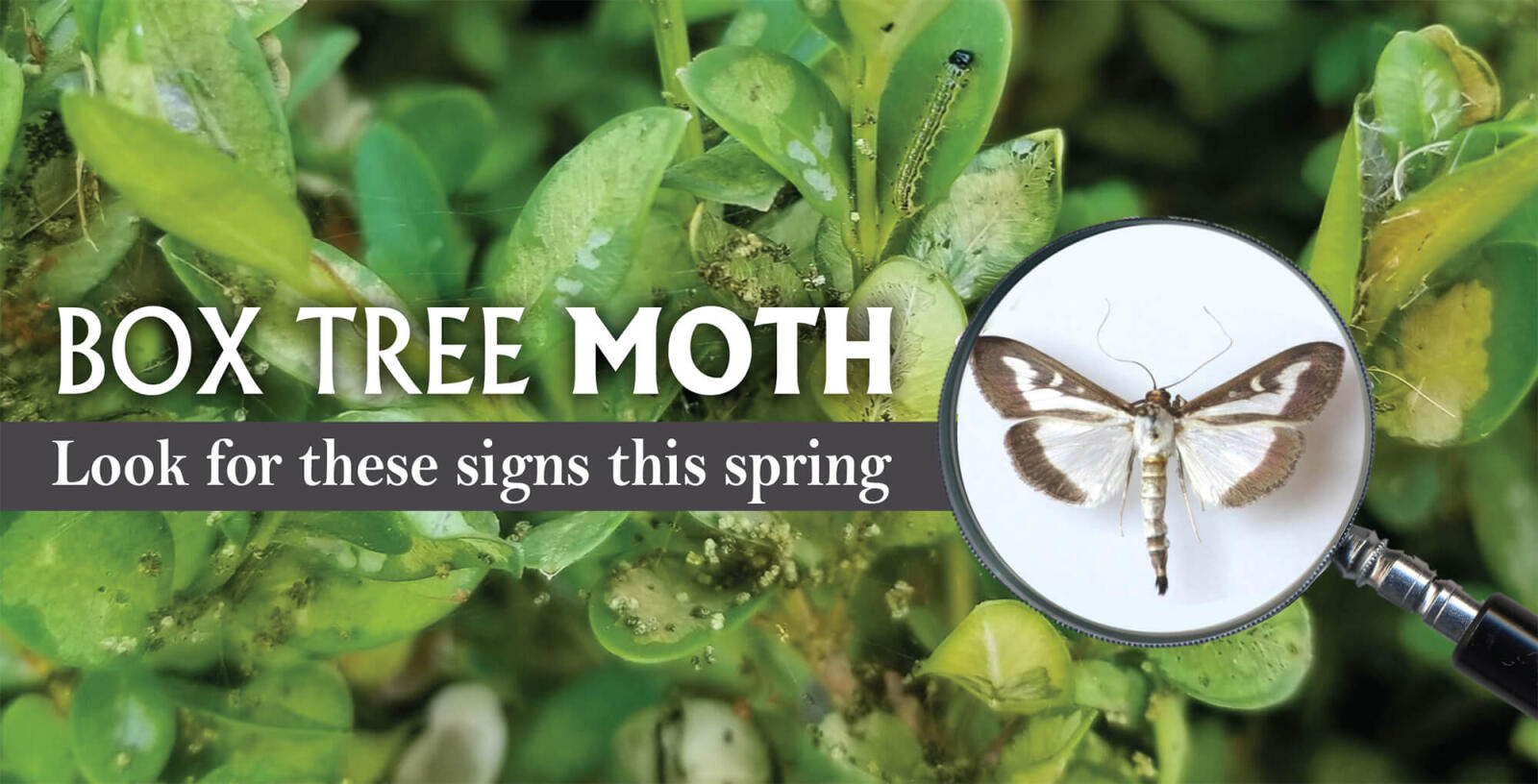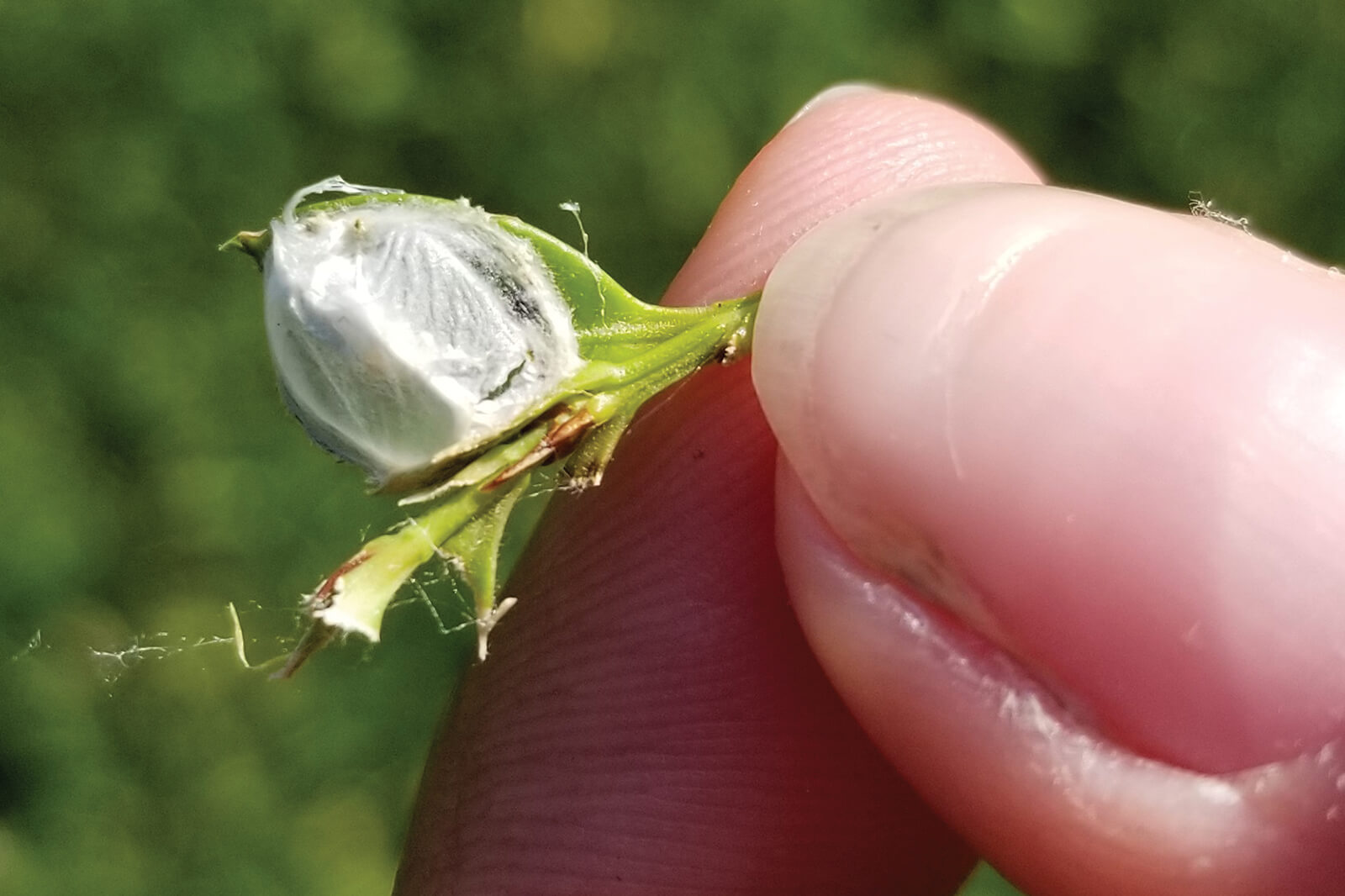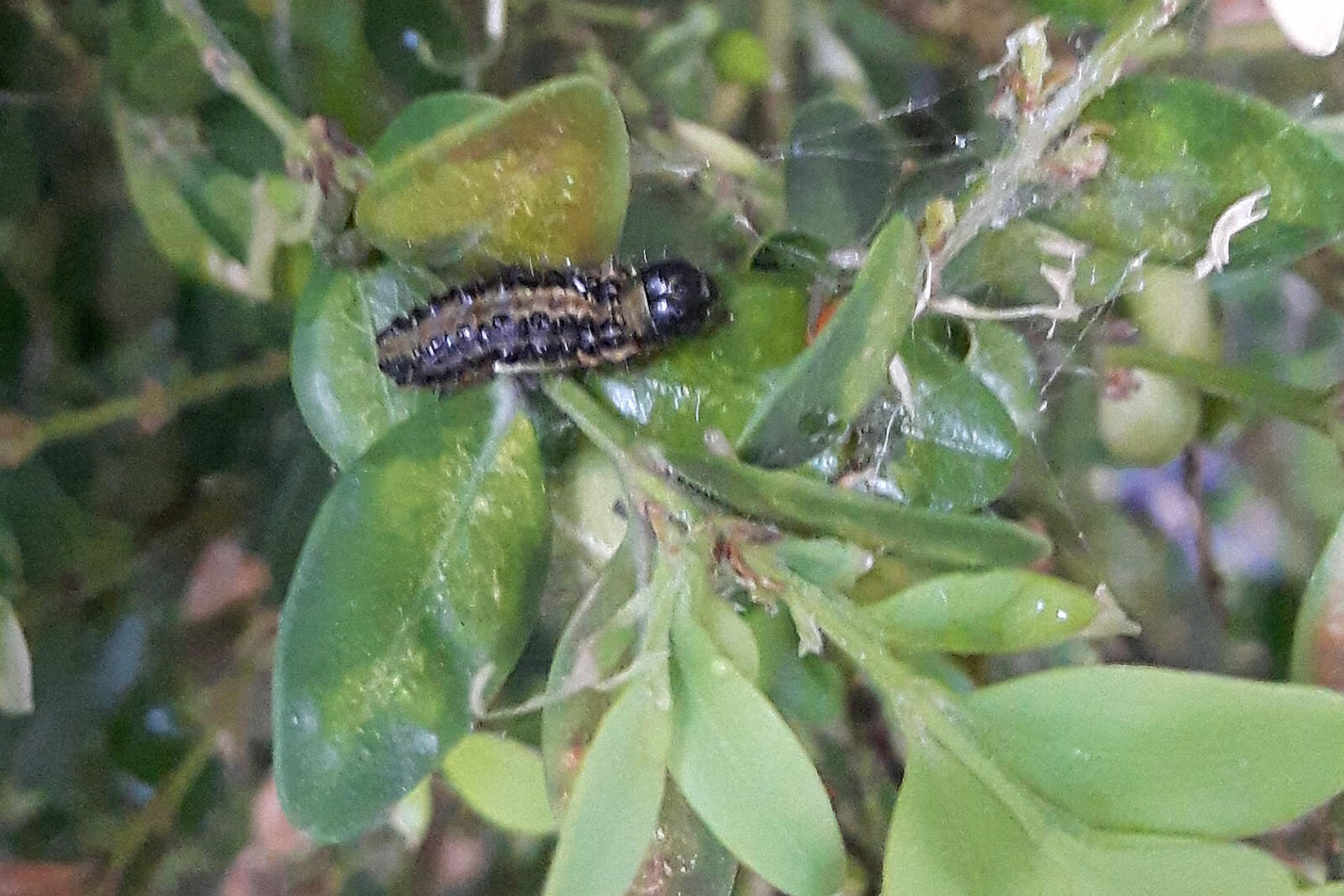May 6, 2020

Box tree moth: Look for these signs this spring
By Jen Llewellyn
OMAFRA Nursery Crops Specialist
@ONnurserycrops
Box tree moth has been detected in residential gardens in Toronto, Ont., with active populations spanning Steeles Ave. to the north, Leslie Rd. to the east, the Gardiner Expressway to the south and Highway 427 to the west.
If you are out scouting for box tree moth in early spring, you will need to look for individual leaves that have a small, visible white cocoon (called a hibernarium), or individual leaves webbed together with a hibernarium in between. Use your fingernail or a knife tip to tease away some of the webbing. If you find a tiny green larva with a black head inside the webbing that is about 4-6 mm long, then you have have found box tree moth. If you find eggs, that is a spider nest.
 Hibernarium: box tree moth larva overwinters inside until the warm days of May.
Hibernarium: box tree moth larva overwinters inside until the warm days of May.
When temperatures become warm in May, the threshold that marks the beginning of larval activity is 15 C. Overwintered early instar larvae will venture out of their hibernarium to feed on surface tissue of the leaves. Young larvae have small heads and mandibles and are only able to feed on the epidermis and shallowly into the underlying mesophyll. Note how only one side of the leaf is chewed, and just from the surface. This tissue becomes desiccated and will turn light brown after a few weeks. Note the webbing and frass amongst the chewed foliage and twigs. Keep in mind that in 2019, we experienced an unusually cold, wet spring that lasted well into the month of June. Where temperatures are warmer, we expect to see larvae more active from early to mid-May.
As larvae mature, they shed the skins (molt) in order to increase their body size. Larvae become more greenish and develop a striking pattern of thick black stripes along their body. With each molt, larvae acquire a larger set of mandibles and will eventually consume entire portions of leaves, often leaving just the margin of the epidermis behind. Note the webbing and frass amongst the chewed foliage and twigs. Where temperatures remain warm, the larvae will feed on the leaves for about 14 days. A second generation of larvae can be found.
 Top photo: Damage from late instar larva of box tree moth. Note how edges of leaf margins are left behind (late June). Bottom: Late instar larvae of box tree moth.
Top photo: Damage from late instar larva of box tree moth. Note how edges of leaf margins are left behind (late June). Bottom: Late instar larvae of box tree moth.
Box tree moth larvae can be effectively managed with Dipel 2X DF and Xentari — biological insecticide products already registered for use in Canada. In fact, Dipel is the same biological insecticide that is applied by air over the City of Toronto to combat Gypsy moth larvae in the spring. Dipel and Xentari contain a naturally occurring bacterium, Bacillus thuringiensis (B.t.), that when sprayed on the foliage, is consumed by the larvae as they feed on the leaves. Within an hour of ingesting the B.t. residue, the larvae stop feeding and then die within two to three days. Foliage needs to be re-treated at least every 10 days to keep an effective layer of B.t. on the leaves during periods of larval activity. We found that one application per larval generation was usually enough to control actively feeding larvae. A second generation of larvae will be active in mid-summer and is another opportunity for insecticidal application.
 Recently killed larva after ingesting Dipel residue on leaf.
Recently killed larva after ingesting Dipel residue on leaf.
OMAFRA Nursery Crops Specialist
@ONnurserycrops
Box tree moth has been detected in residential gardens in Toronto, Ont., with active populations spanning Steeles Ave. to the north, Leslie Rd. to the east, the Gardiner Expressway to the south and Highway 427 to the west.
If you are out scouting for box tree moth in early spring, you will need to look for individual leaves that have a small, visible white cocoon (called a hibernarium), or individual leaves webbed together with a hibernarium in between. Use your fingernail or a knife tip to tease away some of the webbing. If you find a tiny green larva with a black head inside the webbing that is about 4-6 mm long, then you have have found box tree moth. If you find eggs, that is a spider nest.
 Hibernarium: box tree moth larva overwinters inside until the warm days of May.
Hibernarium: box tree moth larva overwinters inside until the warm days of May.
When temperatures become warm in May, the threshold that marks the beginning of larval activity is 15 C. Overwintered early instar larvae will venture out of their hibernarium to feed on surface tissue of the leaves. Young larvae have small heads and mandibles and are only able to feed on the epidermis and shallowly into the underlying mesophyll. Note how only one side of the leaf is chewed, and just from the surface. This tissue becomes desiccated and will turn light brown after a few weeks. Note the webbing and frass amongst the chewed foliage and twigs. Keep in mind that in 2019, we experienced an unusually cold, wet spring that lasted well into the month of June. Where temperatures are warmer, we expect to see larvae more active from early to mid-May.
As larvae mature, they shed the skins (molt) in order to increase their body size. Larvae become more greenish and develop a striking pattern of thick black stripes along their body. With each molt, larvae acquire a larger set of mandibles and will eventually consume entire portions of leaves, often leaving just the margin of the epidermis behind. Note the webbing and frass amongst the chewed foliage and twigs. Where temperatures remain warm, the larvae will feed on the leaves for about 14 days. A second generation of larvae can be found.
 Top photo: Damage from late instar larva of box tree moth. Note how edges of leaf margins are left behind (late June). Bottom: Late instar larvae of box tree moth.
Top photo: Damage from late instar larva of box tree moth. Note how edges of leaf margins are left behind (late June). Bottom: Late instar larvae of box tree moth.
Box tree moth larvae can be effectively managed with Dipel 2X DF and Xentari — biological insecticide products already registered for use in Canada. In fact, Dipel is the same biological insecticide that is applied by air over the City of Toronto to combat Gypsy moth larvae in the spring. Dipel and Xentari contain a naturally occurring bacterium, Bacillus thuringiensis (B.t.), that when sprayed on the foliage, is consumed by the larvae as they feed on the leaves. Within an hour of ingesting the B.t. residue, the larvae stop feeding and then die within two to three days. Foliage needs to be re-treated at least every 10 days to keep an effective layer of B.t. on the leaves during periods of larval activity. We found that one application per larval generation was usually enough to control actively feeding larvae. A second generation of larvae will be active in mid-summer and is another opportunity for insecticidal application.
 Recently killed larva after ingesting Dipel residue on leaf.
Recently killed larva after ingesting Dipel residue on leaf.
What you can do
Raising public awareness on the biology and detection of box tree moth is essential to help control and limit the spread of this pest. Talk to your clients about scouting for this pest on their boxwoods. Employ effective biological pesticide programs and do not move boxwood plants out of the infested zone in Toronto. Since box tree moth has not been detected at or near any wholesale farms and it is a manageable pest, continue to use Ontario-grown boxwood with confidence.- Watch the OMAFRA Box Tree Moth Webinar on the box tree moth page at landscapeontario.com/box-tree-moth.
- Subscribe to the ONnurserycrops blog and @ONnurserycrops on Instagram to receive timely updates.
- Inspect all boxwood plants for signs and symptoms of box tree moth. Take a few minutes to pull branches apart to see inside the canopy and inspect closely for chewed leaves, webbing, frass, cast larval skins, cast larval heads, live larvae or pupal cases. Remember, webbing on its own is not a clear indicator for the presence of BTM since spiders are common on this plant.
- Treat active larval stages with registered insecticides (e.g. Dipel 2X DF) using a licensed applicator. Treatments should be assessed three to five days post-application to ensure all larvae have been killed. Re-treat if active larvae are found during the following larval generation period (noted below).
- Continue to monitor boxwood plants for signs of active larval stages, especially during the periods of May 30 to June 15, July 15 to Aug. 10 and Sept. 1 to 15.
- Box tree moth can be a significant pest if left unmanaged. Spread the word about box tree moth to your local horticultural networking group and encourage others to monitor boxwood for this pest.